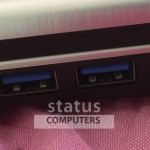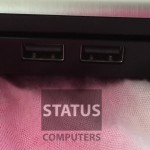Take a look at your computer. Have a close look at the USB ports...
Have you ever looked at the USB ports in your computer and wondered why some of them are a different colour? The answer, if the port is blue is actually a very exciting one. If your USB port is blue (like the image to the left) this means, generally, that you have a USB 3.0 port (or two, like my 'Beast').
USB 3.0 is the third generation of USB technology and has the fastest data transfer rate of the technology so far. It can deliver data transfer speeds of up to 10 Gigabit per second (in a USB 3.1 Superspeed+ or 5 Gbit/s for 3.0 SuperSpeed). It can make a lot of difference when you want to transfer a lot (or very large) files over your USB port.
By contrast, USB 2.0 (generally black - like the below and to the left image) tend to reach a maximum speed of 480 megabit per second). Which, when you find yourself using terabyte and larger external hard drives, can mean the difference between a backup / transfer taking 8 hours and taking just 30 minutes. So, it really does make sense, if you have a USB 3.0 port to use it if you can.
USB 3.0 ports are generally identified by their blue colour, or will display the SuperSpeed (SS) logo for easy identification. This is also often reflected in the colour of the adaptors in the USB 3.0 thumb drives (USB sticks, as I affectionately call them).
Most machines from the last few years, like 'The Beast', have both USB 2.0 and USB 3.0 ports. Now, for some accessories, it can make a difference, whereas there are some that the actual speed of the accessory itself means that it won't take the full advantage of the speed/performance benefit of the USB 3.0. Things like keyboards, mice, headsets etc don't need the added power, so if you have both types of ports available in your machine, it can be a good idea to save the USB 3.0 ports for your thumb drives / external hard drives or other things that will take advantage of the data transfer speed.
Most of the USB compliant technologies are backwards (and forwards) compatible (you can put a USB 3.0 compliant device in a USB 2.0 port and vice versa - some will not perform *as well* as the speed will only be the slower of the two.
Is your USB port *not* blue? Have no fear, some manufacturers (for aesthetic reasons - I'm looking at *you* Apple Inc and your MacBook Air.. well, all your machines) leave the USB 3.0 black (not blue) or some colour other than blue. However, if it *is* blue or has the 'SuperSpeed' logo , it is USB 3.0.
SuperSpeed Logo




